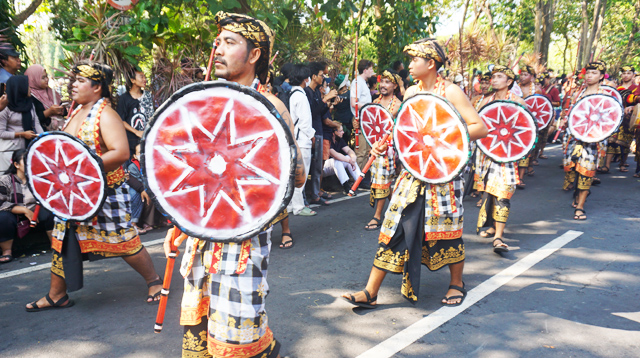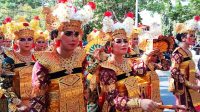THE HINDU community on the Island of the Gods is rich in unique and fascinating traditions and culture. One such dance is Gebug Ende, an ancient ritual dance native to Karangasem, on the eastern tip of Bali. More than just a performance, Gebug Ende is a manifestation of the community’s deep belief in the connection between humans and nature, a sincere prayer expressed in movement and spirit.
The Origins of Gebug Ende: Prayer Amidst Drought
Gebug Ende is deeply rooted in the history and geography of Karangasem. This region is known for having lower rainfall than the southern part of Bali, making it vulnerable to drought. Therefore, for centuries, the people of Karangasem, particularly in the villages of Seraya and Bugbug, have developed this tradition as a ritual to pray for rain from Sang Hyang Widhi Wasa, or the One Supreme God.
Oral history indicates that Gebug Ende has existed since the time of the Karangasem Kingdom around the 17th century. This dance is said to have emerged from the desperation of the people facing a long dry season, when rice fields dried up and water sources dwindled. In these conditions, the ancestors created this ritual as a form of sacrifice and a prayer for rain, bringing blessings to life. This tradition is usually performed around October and November. The name “Gebug Ende” itself comes from the word “gebug,” meaning to strike, and “ende,” referring to a shield made of cowhide or rattan.
Physical Characteristics and Equipment
Gebug Ende is not a dance that emphasizes the elegance of movement alone, but rather a ritual combat imbued with meaning. The dancers, or “pemacul” (players), are generally adult males who have passed their teenage years. They do not wear elaborate clothing, instead displaying simplicity, wearing only traditional Balinese sarongs (kamen) without shirts, showcasing their muscular build as a symbol of strength and endurance.
The main equipment in Gebug Ende is a whip and a shield. The whip, made from palm fiber or palm fronds, is used for striking, symbolizing the power of prayer and supplication. The tip of the whip is sometimes decorated with tassels that, when swung, produce a distinctive squeaking sound.
Meanwhile, the “ende” shield serves as a protective shield, symbolizing self-defense and confidence in facing challenges. The ende can be round or oval, decorated with simple traditional motifs yet possessing spiritual significance.
Philosophical Meaning: Harmony and Sacrifice
Behind the seemingly violent “fight,” the Gebug Ende holds a profound philosophy. The battle between the two strikers is not about hostility, but rather a symbol of the balance and harmony of the universe, the fundamental duality of Rwa Bhineda. The blows delivered and parried reflect the interaction between positive and negative elements, heat and cold, drought and rain. The culmination of this fight is the appearance of blood from the small wounds caused by the whips, believed to be a sacrifice or offering to God, asking for the return of fertile soil and abundant water.
The wounds inflicted are not an act of violence, but rather part of a sacrificial ritual. The community believes that the more blood shed, the sincerer their offering, and the greater the likelihood that their prayers will be answered. This is a form of total surrender and unwavering faith in the power of nature.
Movements and Fighting Dynamics
Gebug Ende is performed by two men facing each other. The fight begins with a solemn preparation ritual, accompanied by powerful and energetic Balinese gamelan music. The men perform warm-up movements, harmonizing with the rhythm of the music and spiritual energy.
When the fight begins, the two men attack and defend each other with their whips and shields. The movements are agile and fast, full of feints and agility. They jump, dodge, and spin, creating an intense fighting choreography. Although it may appear aggressive, there is an unwritten rule that is upheld: avoidance of injury to the opponent’s vital body parts.
The fight usually ends when one of the men is unable to continue, or when the referee deems enough fighting has been done.
Tourist Attraction: Authenticity and Spirituality
For tourists, Gebug Ende offers an authentic and immersive experience of Balinese culture rarely found elsewhere. Gebug Ende is usually held on special occasions, especially during the long dry season or as part of major traditional ceremonies in villages like Seraya, Bugbug, or Sibetan in Karangasem.
Seeing Gebug Ende in person provides an opportunity to witness the spiritual strength and steadfastness of the Balinese people’s faith in upholding their traditions. The sound of the whip cracking…The singing, shouts of the cullers, and the dynamic rhythm of the gamelan create a captivating and unforgettable atmosphere. This is more than just a spectacle, but a window into the souls and ancient beliefs of the Karangasem people.
With all its uniqueness and philosophical depth, Gebug Ende is a living testament to Indonesia’s rich cultural heritage, worthy of preservation and protection. This tradition not only summons rain but also calls us to reflect on our relationship with nature and the power of faith. (*)










